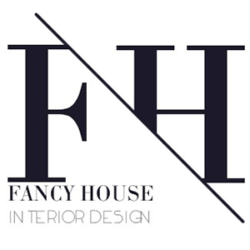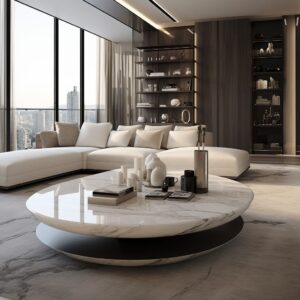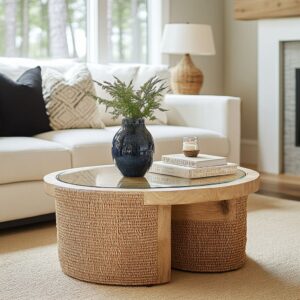A coffee table often sits quietly in the middle of the room—but that silence can carry more meaning than expected. What’s placed on top of it does more than decorate.
It shapes the mood, anchors the atmosphere, and gives structure to the space around it. And lately, the focus has shifted from simply filling the surface to curating it with balance, intention, and texture.
Current styling approaches favor weight over noise, restraint over repetition, and contrast that plays out through material, light, or placement. Sculptural forms, natural elements, seasonal details, and purposeful emptiness now shape how tables are read—not as isolated objects, but as connected parts of the larger interior story.
In this landscape, a tray isn’t just for gathering, and a vase isn’t only for flowers. Everything chosen has to hold its own, whether through shape, reflection, softness, or tension.
This article breaks down the subtleties behind coffee table composition, where scale, shadow, and spacing do the heavy lifting. By studying these quiet techniques—used across many styles and regions—a clearer picture emerges of how the table transforms from surface to statement through thoughtful arrangement alone.
Sculptural Objects as Quiet Centerpieces
In today’s interiors, the surface of the coffee table often holds more than decorative filler—it becomes a stage for form itself. Objects once considered secondary now take the lead, as seen in the use of driftwood, carved wooden knots, ribbed ceramic vessels, or even rough-cut crystals.
These are not props to support a larger arrangement; they are the main act. Their presence relies on shape, weight, and surface quality—each piece selected not to match a theme but to hold space with confidence.
These sculptural accents do not compete for attention with color. Instead, they use volume, texture, and natural variation to define the atmosphere.
A coffee table styled in this way feels more curated, more grounded—almost like a gallery installation brought into a residential setting. This approach quietly reshapes the role of coffee table decor, showing how substance and form can replace expected flourishes.
Without a single petal or bright tone, these objects give depth and personality, making them powerful tools in today’s most effective coffee table decorating ideas.
Negative Space Treated as an Ingredient
An often overlooked element in stylish coffee table composition is the space between the items. These wide, open areas of bare surface are not the result of under-styling—they are part of the plan.
Negative space becomes a design tool, framing each object in a way that lets it breathe and settle into its surroundings. Much like the way white space sharpens the message on a printed page, open areas on a tabletop create visual clarity.
In many refined interiors, the most striking coffee table centerpiece ideas come not from abundance, but from restraint. A single sculptural bowl or carefully placed stack gains presence because it is not crowded.
The surrounding emptiness allows textures to stand out and silhouettes to hold their own. Even in rooms filled with rich finishes or bold materials, this controlled openness keeps the atmosphere calm and intentional.
It also helps the table itself—whether stone, wood, or metal—become part of the composition, rather than just a base for layering.
Tone-on-Tone Palettes With One Temperature Shift
Subtle palettes dominate the best coffee table arrangements—shades of cream, wood, sand, and soft gray working together in quiet agreement. But what gives these compositions energy is often a single shift in temperature.
A hint of amber glass, a muted green ceramic, or a floral note in a deep plum tone is enough to introduce life into an otherwise neutral layout.
These shifts are rarely bold. They whisper through texture or tone, adding warmth or coolness just where it’s needed.
The key lies in their precision. Rather than scattering color across the tabletop, these accents are placed with care, so that the contrast does not overwhelm the base palette.
It’s a restrained way to add rhythm, especially useful in soft-toned spaces where material and shape carry more weight than hue. This strategy—anchoring a tone-on-tone design with a temperature accent—offers a quiet but effective visual pivot that keeps the setting from feeling too flat or too calculated.
Height Triangulation Rather Than Symmetry
Instead of balancing objects with mirror precision, many coffee tables today use soft height variation to guide the eye. This is where the triangle shows its strength—not as a geometric shape, but as a quiet rhythm that moves the gaze.
Three candles of different heights, a grouping of ceramic vases arranged with one slightly taller than the others, or an offset floral stem paired with a low bowl—these setups hint at a peak without formal lines.
This visual triangle works because it feels unforced. The tallest item often sits off-center, with shorter elements rising toward it from either side.
This technique creates visual motion without actual movement, letting the eye rise and fall in a slow, natural arc. Rather than forcing strict balance, the effect draws attention gently across the surface, making the layout feel casual but intentional.
In the context of living room table decor ideas, this method avoids stiffness and brings more dimension to what could otherwise look flat or repetitive.
Containers That Echo Table Material
Some of the most visually cohesive coffee table setups come from a subtle repetition—when the objects echo the table itself. A ribbed ceramic vase on a slatted wood top.
A brass object catching light above a velvet tray. A chunk of driftwood placed on rich walnut.
These are not direct matches, but reflections—one texture acknowledging another. This alignment of surface and object texture does something quiet but powerful: it visually fuses decor with its base.
Rather than looking like items simply placed on a flat surface, the collection feels connected. A carved bowl feels more natural on a rustic top.
A smooth matte piece sits calmly on stone. This relationship forms a kind of invisible glue between object and table, bringing the whole composition together with less effort.
In the world of coffee table decor accessories, this is one of the most understated but effective visual tools.
The Tray Debate: Containment vs. Freedom
The use of trays on coffee tables divides opinion—but both choices are equally deliberate. A tray acts like a soft frame, gathering scattered items into a clear zone of attention.
It creates calm in a busy setting, especially on patterned rugs or next to strong upholstery. Books, vases, and candles look anchored when nestled inside a tray, and the edge naturally stops the eye from drifting.
On the other hand, some rooms work better without this container. Objects are allowed to spread out, giving each its own space and making the entire tabletop feel like open ground.
This unframed look works best when the focus is on form—one sculptural object here, a bowl or stone there—so that every item feels deliberate but relaxed. Whether the table leans tidy or free-flowing, the decision sets the visual tone for the entire room.
Both methods have a role to play in thoughtful living room center table decoration ideas, and often, the choice depends on what feeling the designer wants the room to hold—structured stillness or soft spontaneity.
Transparent & Reflective Elements as Light Managers
Gloss, shine, and reflection are often treated as finishing touches—but in refined coffee table settings, they take a more central role. Surfaces like mirrored trays, polished marble, or clear glass cloches do more than reflect light—they shape it.
Positioned carefully, these elements collect sunlight during the day and flickers of candlelight in the evening, casting subtle changes across the tabletop. They act as quiet lenses, shifting the tone of the surface without adding clutter.
When these gleaming accents are paired with matte finishes—like stone bowls, linen-covered books, or ceramic vessels—the result is a low-key contrast that feels intentional and dimensional. It’s not the objects themselves that demand attention, but the shadows they throw and the glints they catch.
A water-filled vase holding eucalyptus branches, for instance, doubles as a liquid mirror, adding depth while remaining almost invisible. The result is a composition that feels alive through movement of light alone—one of the most understated qualities in thoughtful coffee table decorations for living room spaces.
Botanical Statements That Rely on Shape, Not Color
Plants on the table are expected—but the styling shifts when greenery is chosen for form over vibrancy. Instead of relying on bold petals or saturated leaves, many arrangements lean into structure: eucalyptus that arches like calligraphy, moss that spreads softly like velvet, or pampas grass that rises and falls like drawn lines.
Even the most vivid blooms are selected for their silhouette—long stems that lean, cluster, or sprawl with grace.
The goal isn’t to bring a splash of color but to introduce natural movement. These arrangements complement the lines of nearby furniture rather than compete with them.
They echo curves in a sofa arm, repeat the height of a candle, or balance the width of a shallow bowl. This use of botanicals adds organic rhythm to a coffee table with decor approach that focuses on shape, proportion, and linework—making the plants feel sculptural rather than ornamental.
Functional Objects Upgraded to Art Forms
One of the more subtle shifts in modern coffee table composition is the use of ordinary objects reimagined through material and shape. Leather boxes with brass hinges, smooth matchstick holders made of stone, or notebooks stacked with fabric swatches—these are items that serve a purpose, but they look at home in a display.
There’s no separation between utility and aesthetics here; function is folded directly into the visual language of the room.
This approach prevents the table from feeling overly staged. It also makes each item feel like it belongs—even if it’s as simple as a coaster set or a notebook.
By refining the finish, material, and placement, everyday pieces turn into coffee table decor accessories that support the visual flow of the entire setting. It’s a move that favors quiet polish over decorative clutter.
Seasonal or Contextual Storytelling
What sits on the table often changes with the weather, and that shift carries more meaning than it first appears. Small seasonal cues—like a bowl of fresh figs, a stack of pinecones, or moss layered in a carved wood bowl—create a gentle sense of time passing.
These aren’t centerpieces built to last all year. They are temporary and intentional, capturing a moment that will quietly fade or be replaced.
The effect is subtle but powerful. Items like pears under a glass cloche or dried hydrangeas in a low vase hint at context without spelling anything out.
They allow the table to breathe with the seasons, suggesting that the space responds to the world outside its windows. This approach to coffee table styling doesn’t rely on holiday motifs or themed objects.
Instead, it offers a mood that shifts with light, climate, and natural availability—adding layers of meaning to what might otherwise be read as pure decoration.
Visual Weight Balanced Corner-to-Corner
In many living rooms, balance comes from more than symmetry—it’s found in the way objects pull across a surface. A tall vase in one corner might be visually countered by a wide, dark-toned book in the opposite diagonal.
A floral bowl leans across from a minimal taper candle or a sleek box. This kind of visual tug-of-war holds the tabletop steady, allowing each object to anchor a portion of the space without competing directly.
It’s a simple concept, but when done with care, it avoids clutter and imbalance. One quadrant may feature more volume, but the eye is pulled to the opposing side for resolution.
The result is a layout that feels even without looking forced. In well-considered decor for living room table designs, this technique gives the setup strength and intention, especially when the tabletop is large or unusually shaped.
It allows every item—big or small—to have its role in the overall visual field.
Key Themes
- Quiet authority over distraction. What’s placed on the table isn’t loud—it holds its own through form, mass, and spacing. Shape and volume take the lead, not color or clutter.
- Material conversation. Items speak to their surroundings. Rough wood pairs with smooth stone. Brushed metal sits beside nubby textiles. Even the gloss of a bowl might echo the sheen of the rug nearby. These textures form a silent dialogue that gives weight to the arrangement.
- Purposeful restraint. Every object has a reason to be present—whether it’s scale, a repeated tone, or a shared surface texture. Nothing floats. Nothing feels added last minute. Even the emptier spots on the table play a role in making the whole composition readable.
- Light as an active collaborator. Reflective trays, transparent vases, or the sheen of polished marble are not afterthoughts. They shape how the table appears across the day—catching sunrise glow or bouncing back late afternoon light.
- Narrative through botanicals and artifacts. Greenery and gathered items—whether a clipping from the backyard or a vintage swatch book—introduce memory and place. The table begins to tell a quiet story through what’s laid on it.
By building on these grounded ideas—space, rhythm, visual pairing, and contrast held in check—each tabletop creates more than just a surface. It becomes a visual pause in the room.
The best center table decor ideas don’t fight for attention. They offer a calm, confident arrangement that holds meaning in every inch.























